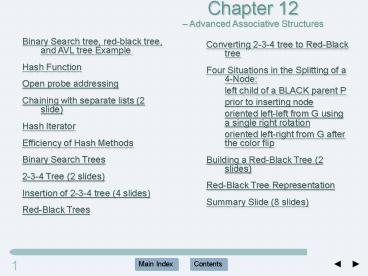Binary Search tree, red-black tree, and AVL tree Example PowerPoint PPT Presentation
1 / 33
Title: Binary Search tree, red-black tree, and AVL tree Example
1
Chapter 12 Advanced Associative Structures
Binary Search tree, red-black tree, and AVL tree
Example Hash Function Open probe
addressing Chaining with separate lists (2
slide) Hash Iterator Efficiency of Hash
Methods Binary Search Trees 2-3-4 Tree (2
slides) Insertion of 2-3-4 tree (4
slides) Red-Black Trees
Converting 2-3-4 tree to Red-Black tree Four
Situations in the Splitting of a 4-Node left
child of a BLACK parent P prior to inserting
node oriented left-left from G using a single
right rotation oriented left-right from G after
the color flip Building a Red-Black Tree (2
slides) Red-Black Tree Representation Summary
Slide (8 slides)
2
Binary Search Tree, Red-Black Tree and AVL Tree
Example
3
Example Hash Function
4
Example Hash Function
5
Hash Table Using Open Probe Addressing Example
6
Chaining with Separate Lists Example
7
Hash Iterator hIter Referencing Element 22 in
Table ht
8
Efficiency of Hash Methods
9
Two Binary Search Tree Example
- Insertion sequence 5, 15, 20, 3, 9, 7, 12, 17,
6, 75, 100, 18, 25, 35, 40
10
2-3-4 Tree Method
11
2-3-4 Tree Example
12
Example of Insertion of 2-3-4 Tree
13
Another Example of Insertion of 2-3-4 Tree
- Insertion Sequence 2, 15, 12, 4, 8, 10, 25, 35,
55, 11, 9, 5, 7
14
Another Example of Insertion of 2-3-4 Tree
(Cont)
15
Another Example of Insertion of 2-3-4 Tree
(Cont)
16
Red-Black Trees
17
Converting a 2-3-4 Tree to Red-Black Tree Example
18
Four Situations in the Splitting of a 4-Node
19
Left child of a Black parent P
20
Prior to inserting node 55
21
Oriented left-left from G Using A Single Right
Rotation
22
Oriented Left-Right From G After the Color Flip
23
Building A Red-Black Tree
24
Building A Red-Black Tree (Cont)
25
rbnode Representation of Red-Black Tree
26
Summary Slide 1
- Hash Table - simulates the fastest
searching technique, knowing the index of the
required value in a vector and array and apply
the index to access the value, by applying a
hash function that converts the data to an
integer - After obtaining an index by
dividing the value from the hash function by
the table size and taking the remainder,
access the table. Normally, the number of
elements in the table is much smaller than the
number of distinct data values, so collisions
occur. - To handle collisions, we must
place a value that collides with an existing
table element into the table in such a way that
we can efficiently access it later.
27
Summary Slide 2
- Hash Table (Cont) - average running time
for a search of a hash table is O(1) -
the worst case is O(n)
28
Summary Slide 3
- Collision Resolution - Two types 1)
linear open probe addressing - the table is
a vector or array of static size - After
using the hash function to compute a table
index, look up the entry in the table. - If
the values match, perform an update if
necessary. - If the table entry is
empty, insert the value in the table.
29
Summary Slide 4
- Collision Resolution (Cont) - Two
types 1) linear open probe addressing -
Otherwise, probe forward circularly, looking
for a match or an empty table slot. -
If the probe returns to the original starting
point, the table is full. - you can
search table items that hashed to
different table locations. - Deleting
an item difficult.
30
Summary Slide 5
- Collision Resolution (Cont) 2) chaining
with separate lists. - the hash table is a
vector of list objects - Each list is a
sequence of colliding items. - After
applying the hash function to compute the
table index, search the list for the data
value. - If it is found, update its
value otherwise, insert the value at the
back of the list. - you search only items
that collided at the same table location
31
Summary Slide 6
- Collision Resolution (Cont) - there is no
limitation on the number of values in the
table, and deleting an item from the table
involves only erasing it from its
corresponding list
32
Summary Slide 7
- 2-3-4 tree - a node has either 1 value
and 2 children, 2 values and 3 children, or 3
values and 4 children - construction of
2-3-4 trees is complex, so we build an
equivalent binary tree known as a red-black tree
33
Summary Slide 8
- red-black trees - Deleting a node from a
red-black tree is rather difficult. -
the class rbtree, builds a red-black tree

